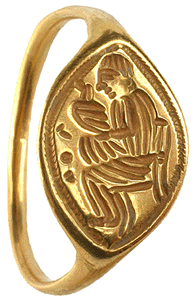...Best of Sicily presents... Best of Sicily Magazine. ... Dedicated to Sicilian art, culture, history, people, places and all things Sicilian. |
by Antonella Gallo | ||
Magazine Index Best of Sicily Arts & Culture Fashion Food & Wine History & Society About Us Travel Faqs Contact Map of Sicily |
In a more general sense, however, there's no doubt that ideas were exchanged between Egypt and Greece. Cleopatra's dynasty was Greek, and she visited Rome. The eastern and central Mediterranean were by no means isolated culturally, even if fashions evolved slowly. The ring shown here, though Phoenician, shows Egyptian artistic influences. How did this work? A boutique in Alexandria starts selling a model of pretty dress that's shipped across the Med for sale in Greece and Italy, spawning a spate of designer knockoffs? This scenario would not be too far-fetched. So much is known from artistic representations of these ancient fashions that costume designers reproduce them faithfully two or three thousand years after they were first popularised. But were the fashions popular in various regions ever similar enough to one another to constitute a genuine Mediterranean trend? Sometimes they were. More often, since traditional craft industries evolved more slowly than today's design process, local tastes usually prevailed. Roman fashion became most popular when the Empire reached its greatest economic and geographic extent. In effect, it was as Roman provinces (or occupied territories) that individual regions became assimilated artistically, though a few resisted. This means that local "fashion shows" did not always reflect the styles popular in other cities. Most interesting, perhaps, is the frequency with which neoclassical styles re-emerge. That's one of the more current conclusions to be drawn from exhibits like this one. The more things change, the more they stay the same. About the Author: Antonella Gallo, who teaches art in Rome, has written numerous articles on arts and artists for Best of Sicily. | |
Top of Page |
 What
did Egyptian,
What
did Egyptian,